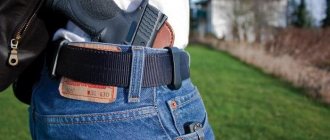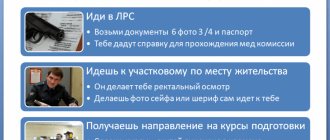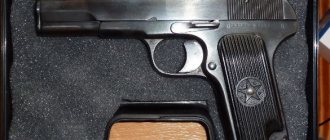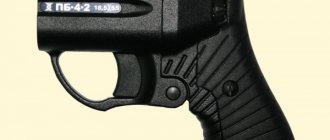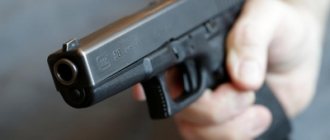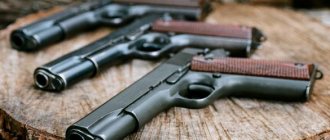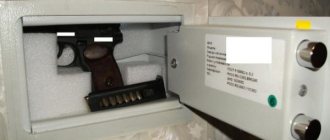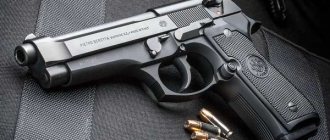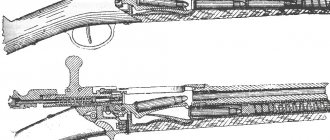Not long ago, the Russian authorities once again tightened weapons legislation, making it much more difficult for citizens to access firearms. But there is one type of weapon in relation to which the screws have long been tightened so that there is nowhere else to go - it would be easier to ban it completely. We are talking about firearms of limited destruction (LDD), which are often called traumatic or simply “traumatic”.
On the one hand, it was introduced into circulation specifically for self-defense, but on the other, not only defense, but also simply wearing “traumatic weapons” is associated with a lot of problems. The abundance of all kinds of restrictions makes it a useless and even dangerous burden. True, lawyers say that knowledge of the laws allows you to circumvent a number of prohibitions. Let's try to figure it out.
What is a traumatic weapon from the point of view of the law?
According to the current legislation of the Russian Federation, civilian models of pistols of various designs intended for self-defense of citizens are considered traumatic or limited-damage firearms. A traumatic weapon may have the following distinctive characteristics:
- Ammunition for traumatic weapons uses a rubber bullet as a striking element, which is not capable of causing serious injuries. Thus, OOOP is designed to temporarily incapacitate the attacker, allowing the defender to escape the scene of the attack.
- The use of a traumatic pistol is permitted only for self-defense purposes. It is for this purpose that various teaching materials have been developed and are available at training centers for shooting such weapons.
- The muzzle energy of traumatic ammunition is limited to 91 Joules - sufficient to cause severe pain and temporarily incapacitate the enemy, but not enough to cause serious damage.
- The magazine capacity of a traumatic pistol is limited to ten charges.
- OOOP should not be able to use solid-state ammunition and conduct automatic fire.
Self-defense weapons can be carried with you and used if necessary only if you have the necessary permits - a license to purchase and carry weapons.
Where can you shoot a traumatic pistol?
OOOP is intended for self-defense and official use by representatives of security organizations. Traumatic weapons are divided into two types: civilian and service. Citizens can only buy LLC models permitted for free sale.
Before purchasing a traumatic pistol, you must pass a medical examination, learn the rules of safe handling of weapons (at DOSAAF or NCOU DPO), obtain a license (at the Central Labor Inspectorate of the Ministry of Internal Affairs or LRO OVD), pay a state fee (2000+500 rubles), buy a safe for storing the traumatic pistol.
Citizens can fire their weapons only if there is a real threat to their life, health, or property. You can use the trauma on the street or on the territory of your own home (cottage, land). Shooting in public places and transport is prohibited.
Slightly different rules for handling OOOP for security guards. Security company employees can shoot in public places (cafes, restaurants) while performing their professional duties. It is forbidden to use trauma unless absolutely necessary.
Who can use traumatic weapons
According to the current legislation of the Russian Federation, permission to carry and use weapons of limited destruction can be obtained upon reaching the age of full majority - 21 years. In this case, a candidate for obtaining permits must meet certain parameters specified in the legislation. Carrying a traumatic weapon, as well as its use, is permitted for the following categories of citizens:
- Serving in the armed forces, the Ministry of Internal Affairs and the Ministry of Justice of Russia.
- Civilians who consider it necessary to protect their lives and health by using traumatic pistols.
- Athletes involved in practical shooting with firearms, as well as instructors.
- Representatives of civil professions involved in protecting themselves or their property from predatory animals (for example, livestock grazing or forestry employees)
- Citizens who are under the state witness protection program.
Application problems
Traumatic pistols appeared on the Russian market in 1999. The first model available was the famous "Wasp". Throughout its history, the Osa pistol was often used in road conflicts, fights, and domestic quarrels. Many opponents of civilian guns argue that such sad statistics could be avoided if the OSA was banned completely.
Experts believe that the widespread use of traumatic weapons is due to the lack of a psychological barrier. If a person does not dare to use a hunting rifle in a fight, since this will certainly lead to serious consequences, then the very fact that rubber arrows are non-lethal seems to give the owner a free hand.
The problem is that non-lethality is relative. In terms of impact effectiveness, a shot from the same Wasp is comparable to a hammer blow. Naturally, if it hits a person wearing a winter jacket, such a blow will be insignificant. But a shot to the temple, neck or eye can be fatal. But if we look at the statistics in terms of the total population, it turns out that there are not so many accidents, as well as crimes, associated with the use of trauma.
Requirements for wearing and using trauma equipment
In order to avoid administrative or criminal liability, it is necessary to comply with the rules of carrying weapons of limited destruction. Thus, the law prohibits:
- Make changes to the design of weapons aimed at increasing the power of the shot, as well as for the use of solid ammunition;
- Carry the pistol loaded (the magazine may be in the grip, but the chamber must remain empty and the safety engaged);
- Carry more than two traumatic pistols with you at the same time;
- Carry a traumatic pistol in crowded places or public transport;
- It is strictly prohibited to carry weapons of limited destruction while under the influence of alcohol or drugs, as well as under the influence of psychotropic drugs;
Self-defense weapons should always be in a holster, without a cartridge in the chamber and with the safety on. There is no need to think about whether a license is needed - the owner must always have identification documents with him, as well as all permits for the right to carry and use firearms of limited destruction.
How to do it correctly
It is allowed to buy civilian weapons specifically for the purpose of self-defense, to protect one’s property, to engage in shooting sports and hunting.
Visiting public places is usually not associated with great risk to life; security there is maintained by law enforcement. Therefore, an ordinary trip to the cinema, to a recreation park, to a cafe or to a concert is best done unarmed.
Weapons should be transported to the place of training, competitions, or hunting in compliance with all precautions. A registered LLC is assigned to the owner; the number of the pistol, carbine, shotgun is indicated in the license issued in the name of a specific person. If a gun or pistol is used by an unauthorized person, the owner will be responsible for the consequences.
In order not to put yourself at risk and not to tempt strangers into taking possession of the gun, you need to carry the pistol concealed, close to the body, in a holster.
If you are going to take part in an event where alcoholic beverages will be consumed, then you need to remember that, regardless of the degree of intoxication, the mere presence of a weapon is already a punishable act.
In what cases can traumatic weapons be used?
A traumatic pistol is allowed to be used only in certain cases - when the life and health of the owner or his loved ones, as well as his property, are in real danger.
The main goal of OOOP is to prevent a serious offense, and not to create it, so the defender must clearly understand the line where he can shoot - between necessary self-defense and an attempt on life and health.
It would be appropriate to use a traumatic pistol against an armed aggressor who poses a real threat to the owner of a weapon of limited destruction. At the same time, according to the legislation of the Russian Federation, the shooter must first warn the aggressor, and also, if possible, fire a warning shot in the air. Only after this is it allowed to open fire on the target at permissible firing distances.
Dangerous areas on the body
Knowledge of dangerous and safe areas can be useful in practice. Firstly, the owner of a traumatic weapon will know where not to aim in order to avoid unpleasant consequences. Secondly, he will know the enemy’s pain points if he behaves too aggressively. Thirdly, it is important to have an idea of which parts of your own body need to be protected first.
The dangerous areas on the human body are the following:
- Crown. This is the most unprotected part of the head. If you hit the parietal part sharply or shoot it at close range, the person can die.
- Temple. It is not uncommon for someone to hit their temple hard and die. This is explained by the fact that under the temple there is an artery of the brain membrane. A shot into this area is fatal. At best, the victim faces fainting and/or concussion.
- Nose. The nasal bone breaks easily, so it is impossible to aim at the head and face area.
- Eyes. Damage to the eye area can deprive the victim of vision. In some cases, the bullet can penetrate the brain and cause serious, sometimes permanent damage.
- Lower jaw. This point is also called the “knockout area.” You can't aim at her.
- Solar plexus. A shot or blow that lands in this area is very painful. It can affect the condition of internal organs.
- Heart. A push into this area can kill a person.
- Stomach. It contains most of the internal organs, so any damage to this part of the body is dangerous. You especially need to take care of the groin area; injuries to it can lead to internal bleeding.
- Knee cap. The kneecap area is very painful; a shot into it can neutralize the enemy. But still, this should be avoided, since the kneecap can be broken, affecting its mobility and leaving a person disabled for the rest of his life.
Shots and distances
Self-defense weapons are designed to cause slight harm to the health of the attacker when shooting at soft tissues. As a rule, the zone of effective safe use of firearms with limited destruction is considered to be a distance of three to six meters. Beyond this distance, a hit may have no effect on the attacker, but closer than three meters it poses a real threat to life or health.
At effective safe shooting distances, a rubber bullet can hit muscle tissue to a depth of one and a half centimeters, causing superficial or penetrating wounds of soft tissue, depending on the density of the aggressor’s clothing. That is why it is necessary to shoot only at permitted places, without causing serious damage.
Introduction
Over the past two decades, there has been a steady increase in the number of injured victims, which is due to a sharp deterioration in the socio-economic and criminal situation, alcoholism and drug addiction [1]. The problem acquired particular relevance after the adoption in 1996 by the State Duma of the Russian Federation Law “On Weapons,” which allowed the acquisition and use of self-defense firearms.
We are talking about the so-called traumatic weapon (or non-lethal - “less-lethal”, as defined by foreign authors), designed to temporarily defeat people and animals in order to suppress their aggressive actions. For the first time, traumatic weapons with wooden bullets as an alternative to military weapons were used by the English police against demonstrators in Hong Kong in 1958, and in the 60s of the last century, rubber and plastic bullets were developed [6]. Despite the definition of such weapons as non-lethal, observations of fatalities from their use have now been published [8-10].
It should be emphasized that in Russia, publications of research results [2-4] on the characteristics of such wounds belong to forensic doctors. In publications by clinicians devoted to chest and abdominal wounds caused by traumatic weapons, isolated observations are provided [5].
The most common injuries are caused by rubber bullets of 18 mm caliber from barrelless traumatic pistols “Cordon”, “Strazhnik” and PB-4 “Osa” (Fig. 1, a).
Figure 1. The most common types of traumatic weapons. a - PB-4 (“Wasp”); b - IZH-79-9).
Until 2001, the “Osa” barrelless weapon with a rubber bullet weighing 8 g and equipped with a steel core had a muzzle energy of 110-120 J, which often caused serious damage and even death, especially when fired at close range [4]. Since 2001, the energy characteristics of the ammunition for this weapon have been reduced to 80-85 J while the bullet mass has been increased to 11.6 g, which has reduced the danger to life but increased the so-called stopping effect.
Since 2004, pistols certified as gas pistols, but with the ability to fire rubber bullets of 9 mm caliber, which were initially produced with muzzle energy from 35 to 70 J, have become widespread. These are Russian-made Izh-79-9 pistols (Fig. 1, b ), WASP-R (Czech Republic), “Jorge” (Ukraine), “Grand-Power” (Slovakia and the Russian Federation), “Steel” (Turkey), “Viking” (Germany and the Russian Federation). However, subsequently, manufacturers gradually increased the energy of some types of cartridges to 130 J, which increased their destructive effect and caused reasonable concern among law enforcement agencies [7].
The purpose of this publication is to present the country's largest experience in the diagnosis and treatment of this largely unexplored type of gunshot wounds of the civilian population from traumatic weapons.
Material and methods
During 2000-2009 at the Research Institute of Emergency Medicine named after. N.V. Sklifosovsky admitted 483 victims with gunshot wounds from traumatic weapons, including 322 with isolated and combined wounds of the neck, chest and abdomen, which amounted to 66% of the total number of victims with wounds from traumatic weapons and 54.4% of the total number of victims with all gunshot wounds neck, chest and abdomen. Of the 322 victims, 308 (95%) were men and 14 (5%) women. The age of the wounded ranged from 16 to 69 years, averaging 31.8±10.2 years. The largest number of victims, both men and women, were people aged 16 to 29 years. Noteworthy is the 9-fold increase in the number of injuries (90 observations) in 2009 compared to 2000 (10 observations). In the vast majority of observations (98.8%), the injuries were of a criminal nature, and in only 4 patients they were the result of auto-aggression.
A retrospective analysis of all observations revealed that in the cold months of the year the number of injuries inflicted by traumatic weapons decreased by almost 2 times compared to the period of warm weather, which, obviously, is not associated with the frequency of use of such weapons, but with a decrease in their damaging effect during presence of thick clothing.
In the table
the location and nature of injuries are presented depending on the type of traumatic weapon. Moreover, in 225 victims the wounds were isolated, in 97 (30%) they were combined with injuries to other areas of the body. In total, 322 victims had 359 wounds to the neck, chest, and abdomen.
The most common combined injuries were: chest + limbs (27), chest + abdomen (11), chest + head (8), neck + chest (8), stomach + limbs (4), neck + limbs (3). The remaining 36 cases were represented by a combination of lesions in more than two anatomical areas (Fig. 2).
Figure 2. A victim with simultaneous injuries from a traumatic weapon to the neck, chest and shoulder. 63% of all wounds were chest wounds. Deep neck wounds accounted for 28.6% of all neck wounds; when fired from an “Osa” type weapon, such wounds were observed in 35.7% versus 19.4% of victims when fired from a “Makarych” type weapon, penetrating chest wounds after shooting from a “ Wasps" amounted to 7.3% versus 3.7% when fired from "Makarych", and all penetrating wounds to the abdomen were inflicted by bullets fired from weapons of the "Makarych" type. All observations of deep and penetrating wounds when firing from weapons of the Makarych type were encountered after 2005 (2006-2009).
results
The appearance of the wounds inflicted by bullets from these two types of traumatic weapons was also different. If the wounds inflicted by bullets from a Makarych-type pistol were mostly round in shape, from 0.9 to 1.5 cm in diameter with relatively smooth edges (Fig. 3, a),
Figure 3. Appearance of wounds caused by traumatic weapons. Explanations in the text. Then the wounds from bullets fired from the Osa had torn edges with a large bruise area, their diameter ranged from 2 to 3 cm (Fig. 3, b). When fired from a long distance, both 9 mm and 18 mm caliber bullets caused superficial damage, which was represented by an area of skin abrasion, bruise and subcutaneous hemorrhage (Fig. 3, c, d).
Superficial wounds of the neck required primary surgical treatment with economical excision of their edges. No foreign bodies were detected in the tissues. In case of a deep wound (as determined by the appearance of the wound), a survey radiography was performed to exclude damage to organs and structures of the neck (Fig. 4, a),
Figure 4. Survey radiographs of victims with wounds from a traumatic weapon. Arrows indicate foreign bodies (bullets). a - with a neck injury; b — with a non-penetrating chest wound; c - with a penetrating chest wound. then longitudinal anterior colotomy (21 observations). In this case, in 1 observation a wound to the trachea was found and in 2 cases there was damage to the oropharynx. Foreign bodies were recovered in 10 cases (bullets from the Makarych pistol - in 6, from the Osa - in 4). Surgical treatment of the wound canal was the final stage of the intervention.
Upon admission of victims with chest and abdominal wounds caused by traumatic weapons, plain radiography was performed. In 217 patients, the wounds were non-penetrating (Fig. 4, b). It should be emphasized that 9 mm caliber bullets are low-contrast and determining their localization during X-ray examination presented a certain difficulty.
In 13 wounded, gunshot injuries to the chest were penetrating (Fig. 4, c). In the absence of indications for thoracotomy, intervention was limited to primary surgical treatment and drainage of the pleural cavity (7 observations). Despite the penetrating wounds, X-ray examination did not reveal any foreign bodies (bullets) in these cases. Two patients in this group underwent delayed thoracoscopy due to a foreign body in the lung or pleural cavity identified on a chest radiograph in the postoperative period. In one of these cases, pneumotomy and removal of an 18 mm caliber rubber bullet, suturing of a lung wound with U-shaped sutures, sanitation and drainage of the pleural cavity were performed. In another observation, an 18 mm rubber bullet lay in the posterior bone-diaphragmatic sinus on the left (Fig. 5),
Figure 5. Thoracoscopy photograph: an 18 mm rubber bullet is visible in the posterior sinus of the left pleural cavity. its removal, sanitation and drainage of the pleural cavity were performed.
Thoracotomy was performed in 6 cases. In 2 patients, the indication for it was a low localization of the wound with a suspected thoracoabdominal wound on the right, while one of these patients had a tangential non-penetrating wound of the diaphragm - an 18 mm caliber bullet lay freely in the pleural cavity, the other had a subpleural hematoma and a lung hematoma without foreign body (according to the victim, the shot was made from a barrelless weapon at close range).
In one victim with a wound to the left side of the chest, a 9 mm caliber bullet, according to the preoperative examination, was located in the area of the heart. Thoracotomy revealed that it lay on the anterior wall of the pericardium without damaging it. In one patient, a left-sided thoracotomy was performed due to the presence of multiple chest wounds with hemothorax and a foreign body in the lung tissue; an 18 mm rubber bullet was removed and the lung wound was sutured. In another victim, due to the presence of an extensive wound in the middle lobe of the right lung, during thoracotomy, a 9 mm rubber bullet was removed and a marginal resection of a section of lung tissue was performed.
Two observations deserve special attention.
Patient Sh.,
26 years old, with a gunshot wound to the chest on the right, was taken by an ambulance team to the operating room of the Research Institute of Emergency Medicine named after. N.V. Sklifosovsky, bypassing the emergency department. The patient's condition is serious, he is somewhat lethargic and lethargic. According to him, he received a gunshot wound from an unknown person. The oval-shaped wound, measuring 2.0×1.5×1.3 cm, with a sagging zone, was located in the fourth intercostal space on the right along the anterior axillary line. There were no signs of external bleeding. Blood pressure 100/75 mm Hg, heart rate 96 per minute, respiratory rate 23 per minute. Breathing on the lower right side is weakened, and there is a shortening of the percussion sound. X-ray and ultrasound showed signs of right-sided hydropneumothorax.
The patient was operated on 15 minutes after admission. Under local anesthesia, drainage of the right pleural cavity was performed, about 500 ml of fresh blood was obtained, after which the separation of blood stopped, but the flow of air continued. The operation was completed with primary surgical treatment of the wound: during revision, the wound canal in the fourth intercostal space penetrated into the right pleural cavity.
Due to the large supply of air through the drainage, immediately after this operation the victim underwent a CT scan of the chest (Fig. 6, a):
Figure 6. Examination data of the victim Sh. a - computed tomogram before surgery; b — plain radiograph of the chest before discharge from the hospital. there was a foreign body (bullet) in the hilar sections of the right lung, compressing the lumen of the upper lobe bronchus. Traumatic infiltration of II, III, VI, VII, VIII, IX, X segments of the right lung against the background of partial collapse. Despite the presence of pleural drainage (according to Bulau), against the background of minor hemothorax (230 cm3), there was a large-volume pneumothorax (1100 cm3). Emphysema of the soft tissues of the right surface of the chest wall, fracture of the 2nd and 3rd ribs on the right were determined.
Under endotracheal anesthesia, an anterolateral thoracotomy was performed in the fifth intercostal space on the right. There is about 400 ml of blood in the pleural cavity. On the anterolateral surface of the upper lobe of the right lung in the projection of the third segment, a wound with a diameter of 2 cm is identified, from which air and some blood flowed abundantly. Along the edges of the defect there is a zone of non-ventilated lung parenchyma with a diameter of 3 cm. At the bottom of the wound at a depth of about 5 cm there is a foreign body - a bullet. There is a slight hemorrhagic penetration of the tissue of the upper lobe of the lung from the root side, there is no bleeding. The lung wound was expanded and the 9 mm bullet was removed. At the bottom of the wound, a segmental bronchus (B3) with a lateral defect measuring 3x6 mm with sharp angles was identified. The defect was sutured with a 4/0 polydioxanone thread on an atraumatic needle. The defect in the lung was sutured in layers with 2/0 vicryl. Hemostasis, aerostasis. Atelectatic areas of the lung are straightened. Further inspection revealed a rib fracture in the area of the gunshot wound with blood leaking. Ligation was performed with suturing of the intercostal artery. The pleural cavity is additionally drained in the second intercostal space along the midclavicular line, the chest wall wound is sutured in layers. Intraoperative blood loss was about 1000 ml, blood was reinfused with a Cell-saver device.
The postoperative period proceeded without complications. Drains from the pleural cavity were removed on the 5th day after surgery. The wounds healed by primary intention. The sutures were removed on the 8-10th day. Control radiography (Fig. 6, b): in the second intercostal space on the right, homogeneous, low-intensity shading with uneven, unclear contours is determined. Throughout the rest of the lung fields are transparent, the roots are structural, the diaphragm is located normally, the median shadow is not displaced. The patient was discharged in satisfactory condition on the 16th day.
If there were abdominal wounds, they underwent primary surgical treatment with removal of the bullet (Fig. 7)
Figure 7. Intraoperative photograph showing a 9 mm bullet in the soft tissue of the abdominal wall. and if a penetrating nature of the damage was detected, a median laparotomy was performed (3 observations). In one case, the serous membrane of the small intestine was damaged, in another there was a contusion of the small intestine (resection of the small intestine was performed and enteroenteroanastomosis was performed), and in the third there was a through wound to the left lobe of the liver, accompanied by blood loss of about 1600 ml.
Patient K.,
27 years old, taken by an emergency medical team to the operating room of the Research Institute of Emergency Medicine named after. N.V. Sklifosovsky, bypassing the emergency department, with a diagnosis of a gunshot thoracocervical chest wound and a blind gunshot wound to the abdomen from a traumatic weapon. It was not possible to collect an anamnesis in connection with alcohol intoxication. The patient's condition is serious. Lateral and below the left sternoclavicular joint, a strip of skin abrasion began, about 5 cm long and 1.2 cm wide, following from the bottom up to the neck and ending with an area of crushed skin of the neck above the anterior leg of the left sternocleidomastoid muscle. The second wound with a diameter of 1-1.2 cm with a band of aggravation and without signs of external bleeding was localized in the right hypochondrium. Ultrasound did not reveal any free fluid in the pleural and abdominal cavities.
30 minutes after admission, the edges of the wound of the anterior abdominal wall were excised under endotracheal anesthesia. The wound channel ran from front to back, from top to bottom and penetrated into the abdominal cavity. A midline laparotomy was performed. There are 1500 ml of blood and clots in the abdominal cavity. The blood was collected using a Cell-saver device. During the inspection, a through gunshot wound of the fourth segment of the liver was revealed: a star-shaped wound, measuring 7x5x7 cm, with bleeding. The wound was sutured with 2/0 vicryl. Hemostasis has been achieved. Upon further inspection, no damage to other organs was found, and no foreign body was found. The operation was completed by sanitation and drainage of the abdominal cavity, and primary surgical treatment of the tangential thoracocervical wound on the left. The total blood loss was 1600 ml of blood, 600 ml of the cellular component was reinfused.
The postoperative period proceeded without complications. On the 4th day, drainage from the abdominal cavity was removed. The wounds healed by primary intention. A repeat ultrasound of the abdominal cavity revealed a heterogeneous zone of low echogenicity with uneven contours, measuring 3.2×1.6×0.5 cm, in the IV segment of the liver, with no signs of blood flow on color Doppler mapping. On the anterior surface of the liver in the same place there were small hypoechoic structures and a zone of reduced echogenicity measuring 3.8×0.7 cm. X-ray of the abdominal cavity did not reveal a foreign body. The patient was discharged on the 11th day in satisfactory condition.
In the remaining victims with penetrating abdominal wounds, the bullets were removed during surgery. In one of them, a round bullet with a diameter of 9 mm lay freely between the loops of the small intestine, in the other, the same bullet, partially fragmented, was removed from the pelvic cavity.
It should be noted that 33 victims with superficial wounds of the neck and non-penetrating wounds of the chest and abdomen, at their insistence, were not hospitalized after the operation and were sent for outpatient treatment. One patient with a non-penetrating chest wound refused surgery.
Of the 288 hospitalized patients, 12 (4%) developed postoperative complications in the form of suppuration of the postoperative wound. There were no deaths. The length of hospital stay averaged 7.4±2.4 bed days.
Thus, the number of gunshot wounds from traumatic weapons has increased 9-fold over the past 10 years; injuries predominate in the summer.
The most common wounds are the chest (71%). Injuries to the neck are observed in 22%, and to the abdomen - in 18% of victims.
With a deep wound to the neck, every third victim has damage to vital structures.
Deep wounds to the neck and penetrating wounds to the chest are more common when using barrelless traumatic weapons of the “Wasp” type, however, more severe damage to the internal organs of the chest and abdomen in recent years has begun to be observed when wounded by 9 mm caliber bullets.
Where you can't shoot
According to current legislation, it is prohibited to shoot at particularly vulnerable places - the head (specifically, the back of the head, temporal part and face), neck, chest (applies only to women), as well as the groin and the location of vital organs. Thus, it is allowed to fire only at soft tissues of the body, for example:
- Stomach
- Hips and legs
- Forearms
- Gluteal muscles
- Back
At the same time, it is not recommended to shoot at distances closer than three meters, in order to avoid serious injury.
Responsibility for violations of the rules for storing traumatic items
Responsibility for violations of the rules is administrative. For storage without a license, it will be the same as in other cases.
Responsibility for violation is provided for by the Administrative Code of Russia.
Article 20.8 states that if citizens violate storage rules, a fine of 3,000 to 5,000 rubles is provided. In this case, administrative arrest is possible for a period of five to fifteen days.
The full text of the article can be found at the link: https://www.consultant.ru/document/cons_doc_LAW_34661/9dbcd81b03e1f4963dfbe98bb8534b35dc88ee8c/.
Please note: Article 222 of the Criminal Code of the Russian Federation makes a reservation that the first three parts, where violation of storage rules are mentioned, do not apply to smooth-bore weapons.
Administrative liability occurs only in the absence of signs of a criminal offense. For example, if a smoothbore pistol was lost and a robbery was committed with its help, then its former owner can be considered an accomplice.
What to do after using a weapon
After the owner was forced to use a traumatic pistol, it is necessary to take a number of actions, in accordance with current legislation. The procedure is as follows:
- It is mandatory to notify law enforcement agencies about what has happened, and it is best to call police officers to the scene of the incident.
- Take a photograph of the scene, making sure to indicate the location where the attacker was located, as well as the location from which the shot was fired. In addition, it is necessary to photograph the extracted cartridge case (in the case of weapons that maximally imitate combat samples).
- Call an ambulance (if the attacker remained at the crime scene due to injury caused by the shot).
- Detain witnesses, if any, until law enforcement officers arrive.
All these actions are intended to maximally “whiten” the defender in the eyes of law enforcement agencies. In the opposite case, the person defending himself may be held accountable, even to the point of attack (depending on the imagination of the victim of the shot and witnesses), and this may entail prosecution under several articles of the Criminal Code of the Russian Federation.
Who is prohibited from keeping weapons?
You can buy a firearm only after obtaining a license. First, you need to undergo a file check to ensure that you have no unexpunged or unexpunged convictions. The medical report is signed by specialists from the drug dispensary and a psychoneurologist. Weapons training courses are included in the package of documents, without which you cannot obtain a license.
Thus, citizens who have passed all pre-licensing inspections can buy a shotgun, carbine, or pistol.
The purchase of a traumatic weapon by hand (from a neighbor, relative) by a person who does not have a license is an illegal transaction. According to Article 20, paragraph 8 of the Code of Administrative Offenses (CAO) of the Russian Federation, both participants who violated the law will pay the fine. The Criminal Code of the Russian Federation contains Article No. 222, according to which they are held accountable for careless handling of weapons resulting in the death of a person or causing harm to health.
What is the permissible limit of self-defense
The permissible limit of self-defense, or necessary defense (according to the law) is a set of actions aimed at eliminating the threat to the life or health of the defender. That is, until there is a real threat to your life or health - the aggressor is not trying to hit or start a fight, or does not demonstrate the intention to attack with some kind of weapon in his hands, the use of self-defense weapons is illegal. Accordingly, the use of a traumatic weapon against a threat can be regarded as exceeding the limits of necessary self-defense.
If the situation allows it, it is recommended to videotape the conflict on a mobile phone or try to bring the conflict under the lenses of CCTV cameras, fortunately there are a lot of them now. This will help you prove your case during proceedings with law enforcement agencies.
To put it simply, the limits of necessary self-defense are not violated if the attacker was not harmed more than could have been inflicted on the defender. And the best thing is to invite a lawyer during the proceedings and testify only in his presence.
What is muzzle energy of a shot
Muzzle energy is the kinetic energy of a bullet. It gets its name from the fact that the projectile is ejected from the muzzle of the weapon. This value is measured in Joules internationally.
In simple terms, muzzle energy is the power of a weapon.
To calculate this value, you need to know the mass of the bullet and its flight speed. The calculation formula is as follows: E=(m*V2)/2.
Punishment for exceeding the limits of permissible self-defense
Exceeding the limits of permissible self-defense implies that shooting from a traumatic pistol or revolver caused serious bodily harm to the attacker, and also if the shooter unintentionally killed the attacker. The criminal law of the Russian Federation is imperfect, and exceeding the limits of self-defense, due to the lack of specific legislative norms on the term “self-defense,” the defendant may be charged with serious crimes - for example, an attack on the life of another person.
Responsibility for exceeding the limits of necessary self-defense is established by Articles 108 and 114 of the Criminal Code of the Russian Federation.
Shooting from traumatic guns
The law does not clearly explain what situation can be considered critical when there is an urgent need to use weapons. In practice, it is difficult to prove that the use of trauma was necessary, and if the attacker also received bodily injuries, then a criminal case is opened against the defender. You can try to formulate rules for the use of traumatic weapons, immediately consulting with experts and lawyers. Let us remind you in advance that there are no such rules in the law, but from judicial practice it becomes clear how the owner of a weapon should behave so as not to change places with the aggressor.
Step 1: Warning. In America they say that if you take out a weapon, you need to shoot. This saying does not contradict their laws; it has a rational grain, since to ensure their safety everyone must be morally prepared to fire a shot. Otherwise, the sight of an inactive weapon will only anger the aggressor, and the outcome may become more disastrous. But our laws do not accept this approach.
Before opening fire, the defender is obliged to warn the aggressor about this. How can this be done? Unfortunately, the law does not specify the procedure, but the attempts made will be taken into account during the proceedings. Therefore, you should express your intentions repeatedly. This includes phrases, warnings, jerking the shutter, and finally, a shot in the air. Note that there is often not enough time for warnings, since every second counts. Injuring an enemy will certainly entail criminal liability, therefore, having picked up a weapon, everyone must make their choice ahead of time.
Step 2. Shooting from a traumatic pistol. If we consider the law, we may encounter a paradox in which the criminal has more rights than the defender. The main rule of shooting, as a reminder, is formulated and written on the cartridge packaging. You cannot shoot from a distance of less than one meter, and you cannot aim at the head and neck. Otherwise, your actions will be regarded as intentional. The owner of a traumatic gun has a difficult choice in winter, when the enemy is wearing a thick jacket or other piece of outerwear. All that remains is to shoot at the legs or unprotected parts of the arms. Here you will need to demonstrate your skills. In summer, the affected area is much wider. Exceptions are the head, neck and groin.
Step 3. Notification of competent authorities. Any case of use of a traumatic weapon should be reported to the police immediately. According to the law, a day is allotted for this, but your quickness can play into your hands. In parallel with waiting, the police will have to carry out a number of other measures to protect themselves.
- If injured, the victim should be provided with emergency medical care and an ambulance should be called. If the enemy tries to hide, you need to remember his appearance.
- It is advisable to take a position in which your actions will be recorded on a video camera, of which there are now many near shops, shopping centers and other establishments. If there is no camera, then after the incident is resolved, you should photograph the area.
- Try to convince passersby to participate as witnesses and wait for the police to arrive.
- You must not touch the cartridges after firing.
Step 4. Primary explanations. This step is considered the most difficult, as it can be decisive in the case. You should not expect that the police will immediately treat you as a victim. For them, the situation is obvious - you used a weapon and caused harm to a person’s health, which means you are the culprit. You must write an explanation, and in your own hand. All tips from operatives may have double standards, so it is better to refuse them. If a police officer records a statement from your words, then carefully re-read the contents before signing. If there are any comments, they should be indicated in the same document. The police may be against it, but that is your right. Be sure to indicate exactly what the threat to your life was. When you visit the police department again, hire a lawyer. You shouldn't hope that you're right.
